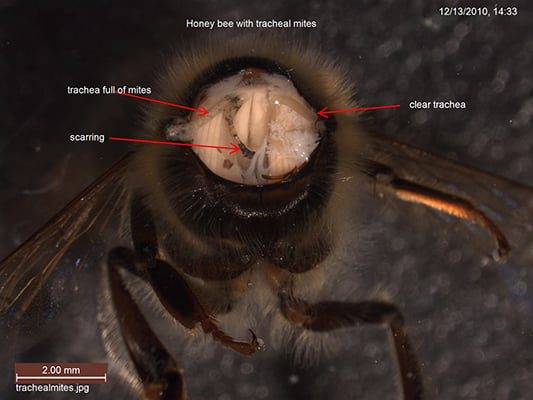The tracheal mite (Acarapis woodi) lives in the trachea (breathing tubes) of adult bees. Mature female mites are attracted to young adult bees (less than 3 days old) via hydrocarbons on the bees’ cuticle.
Mites can be found in all bee castes; however, workers are the prime host due to their larger numbers in a colony compared to the drones and the single queen.
Mites enter the trachea via the opening in the thorax at the base of the bee’s wings. Males take 11-12 days to reach maturity, and females take 14-15 days. Mating takes place within the trachea.

The left trachea is infested with tracheal mites, while the right is healthy. South Chilterns Beekeepers’ Association
Mites feed on the bee’s haemolymph through the tracheal wall, which leaves scar tissue in the trachea. This shortens the bee’s lifespan. When present in large numbers the mites may reduce oxygen flow.
Tracheal mites impede winter survival by causing a reduction in brood area, decreasing bee populations and looser winter clusters, increasing honey consumption, and reduced annual honey production. Infestation is often more pronounced in winter due to the longer lifespan of workers and the lower number of new hosts.
When the mites reach a new part of the world there tends to be serious bee losses. This is much more likely in cooler areas of the world, as effects are more pronounced in winter. Over time resistance traits will emerge.
Dispersing mites are vulnerable to desiccation and starvation, and their survival depends on optimal temperature and humidity. Direct sunlight impedes mite population growth. Hive treatments include grease patties (2 parts solid hydrogenated vegetable oil to 1 part sugar), menthol crystals, formic acid and acaricides (pesticides that kill ticks and mites). Both menthol and formic acid may have negative effects on both bees and beekeepers. It is possible to select for tracheal mite resistance in bees.
Diagnosis requires access to a microscope. This video provides an excellent guide to performing the dissection. Normal trachea are clear, colourless or pale amber. Infested trachea show patchy brown or black discolouration.
Tracheal Mites, Jamie Ellis from the University of Florida
If you detect mites in your colonies please call the Exotic Plant Pest Hotline on 1800 084 881. The tracheal mite is currently not present in Australia. A closely related, but external mite, Acarapis externus has been reported in Australia. However, A. externus has not been reported to cause visible symptoms or injury to bees. Nor has a third species of external mite, Acarapis dorsalis, which has not been found in Australia.
Acknowledgements:
- D. Somerville (2011) Tracheal Mite. Primefact 1092, NSW Department of Primary Industries
- D. Sammataro, L. de Guzman, S. George, R. Ochoa, G. Otis (2013) Standard methods for tracheal mite research. Journal of Apicultural Research 52: 1-10.
- This article has been peer-reviewed by Rod Bourke and Madlen Kratz.

